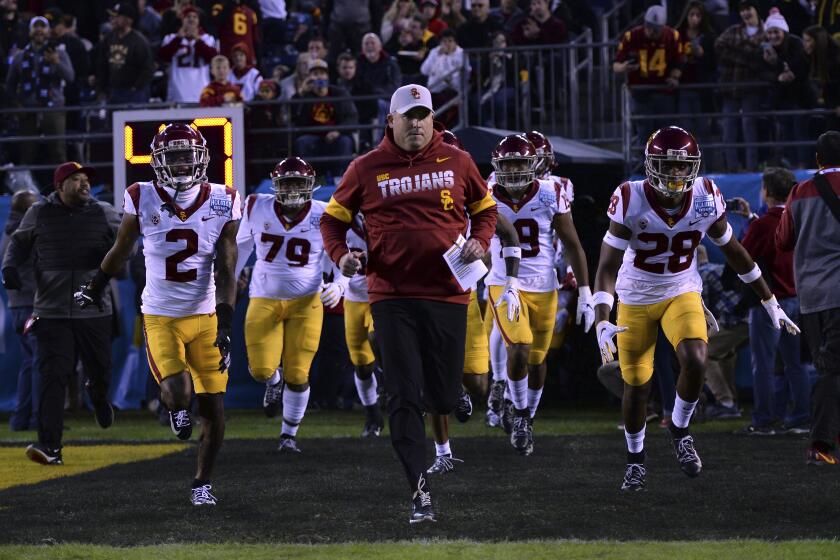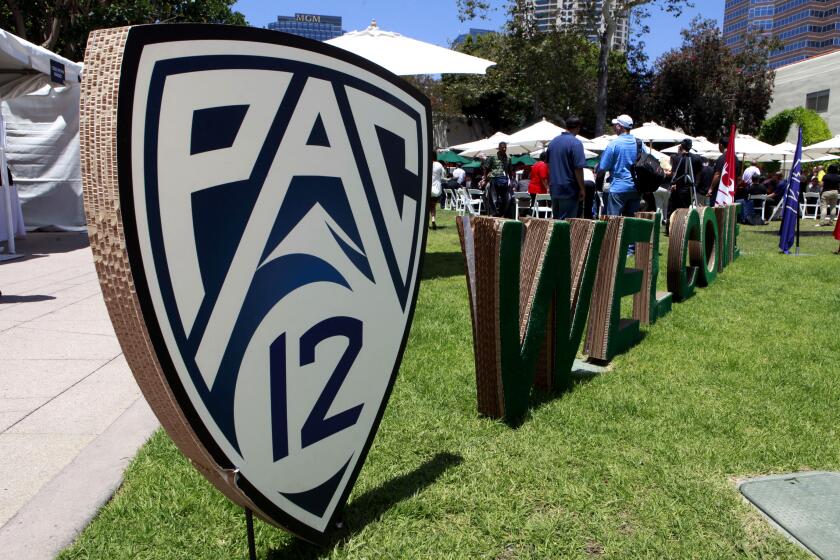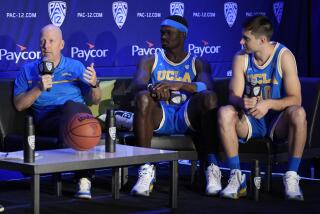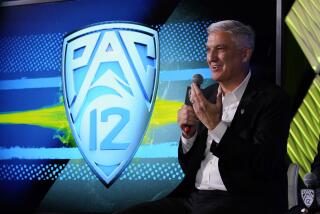How USC was proactive in pushing for a Pac-12 football season
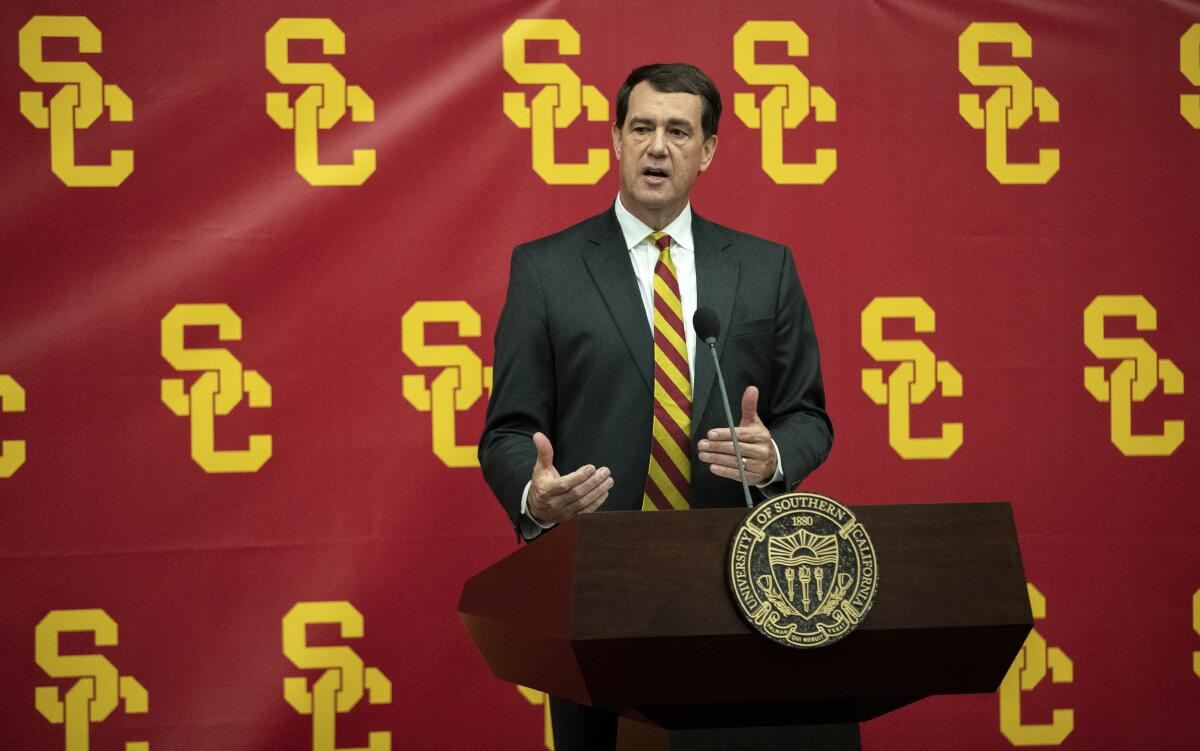
- Share via
With the Big Ten Conference’s return imminent and the Pac-12 still stagnant, USC’s football team penned and published an open letter to Gov. Gavin Newsom on Sept. 15, pleading with him to ease state restrictions and remove one of the last hurdles in their path to playing.
Twelve days had passed since the Pac-12 announced a major breakthrough in testing for the novel coronavirus, and the conference still seemed just as far away from returning to competition. The reality that the Pac-12 was now the last Power Five conference on the sideline “clearly had a big effect” on the players, USC athletic director Mike Bohn said.
“They recognized they were the outlier,” Bohn said.
That realization hit Amon-ra St. Brown as the USC wideout spent a weekend watching other football leagues carry on without the Pac-12. He called USC coach Clay Helton that Sunday and wrangled a handful of team leaders to discuss how they could make their desire to play known. They consulted with administrators, drafted a letter and then brought it to the team for a vote over Zoom, before sending it.
The players simply wanted their voices heard. The timing of their message, just before the Big Ten’s announcement, was deliberate, quarterback Kedon Slovis said.
“After that happened,” Slovis said, “I kind of thought there’s no chance they’re not going to let us play.”
What players couldn’t have understood was that their letter would be the tipping point after weeks of back and forth and subsequent inaction, finally bursting open the bureaucratic floodgates and shifting the burden of responsibility for the Pac-12’s return onto the state of California, where the governor, a former college baseball player, had long positioned himself as an advocate of college athletes’ rights.
Here are five questions facing USC as the Trojans prepare to start a delayed and shortened college football season.
“As California goes, so too does the Pac-12 Conference,” the players wrote in their letter.
The impact was felt throughout the conference. By the next day, Newsom was on the phone with Pac-12 commissioner Larry Scott for the first time. By that night, local health officials in Los Angeles had come to an agreement with USC and UCLA. By the end of the following week, the Pac-12 announced its return for a seven-game schedule, starting Nov. 6.
Bohn didn’t hesitate to connect those dots Thursday, offering effusive praise of his players, who he said “seized the moment.”
“The impact [the letter] had on our return to play is self-evident,” he said. “I’m really proud of them. I’m not sure where we’d be without their leadership.”
In the days leading up to the letter’s arrival at the governor’s office, USC administrators also seized their own leading role behind the scenes, according to two people with direct knowledge of their efforts. While the Pac-12 continued pointing to its testing partnership with Quidel Corp. as “a game-changer” and its member schools waited on next steps, Bohn and his leadership team took a more active role in laying the groundwork for a return, coordinating with state officials, organizing Zoom calls, sharing plans and models with other Pac-12 programs, and prodding the conference to push forward.
Until last week, one person told The Times, top officials at two of the four California schools didn’t know who they were supposed to contact at the governor’s office.
USC had been in regular contact with Lande Ajose, Newsom’s higher education policy advisor, for weeks.
The process leading from Sept. 3, when the Pac-12 first announced its partnership with Quidel, was marked by similar paralysis, prompting some frustration from conference administrators. USC had reached out shortly after the announcement to inform the Pac-12 that relief from state and local health restrictions was necessary before the league could move forward.
Pac-12 Conference university presidents and chancellors voted Thursday to start playing a seven-game season on Nov. 7.
It took a week for a meeting to be arranged between the conference, the four California schools and government relations representatives from each. That Zoom meeting eventually led to meetings with schools in Oregon and Washington, where similar hurdles existed.
Eager to re-establish its place as a leader in the Pac-12, USC saw an opportunity to take the reins. Those efforts, especially in prodding officials into action, were felt across the conference, according to a person affiliated with another school who requested anonymity because of the sensitivity of the subject.
“The athletic directors in the conference recognized that USC was going to do everything they can to take a leadership role in trying to get some of these doors and conversations started,” Bohn said Thursday. “That clearly happened.”
Still, progress at the state level, where officials were dealing with wildfires and far more pressing issues, was at a standstill. State officials seemingly didn’t perceive urgency on the part of the Pac-12, after it voted less than a month earlier to postpone the season until January. Despite demands from Pac-12 players involved with the #WeAreUnited movement, the state wasn’t immediately swayed by their desire to return either.
That changed with the letter, which seemed to light a fire under Newsom.
- Share via
California Governor Gavin Newsom says state guidelines do not prohibit the Pac-12 from playing college football.
When asked about its contents during a daily address Sept. 16, the governor said:
“I want to make this crystal clear. Nothing in the state guidelines deny the ability for the Pac-12 to resume. Quite the contrary. That has been a misrepresentation of the facts.”
But even as the Pac-12 announced its return more than a week later, state and local restrictions meant to “minimize physical contact” remained in place as of Friday, keeping USC and other schools from practicing in groups of more than 12.
Bohn called the situation “a work in progress.” Helton said Friday that USC was planning to begin practice Oct. 9.
With the Big Ten set to return, the conversation about the Pac-12 would have happened eventually. But it was the letter that communicated the urgency of college football’s return to the state — and the conference.
“When the governor hasn’t had direct contact with the commissioner prior to that, I think that gives you a pretty clear indication,” Bohn said. “My hat’s off to the governor responding so quickly and picking up the phone and calling Larry Scott. We just hadn’t had those corner-office conversations up until that point.”
More to Read
Go beyond the scoreboard
Get the latest on L.A.'s teams in the daily Sports Report newsletter.
You may occasionally receive promotional content from the Los Angeles Times.

